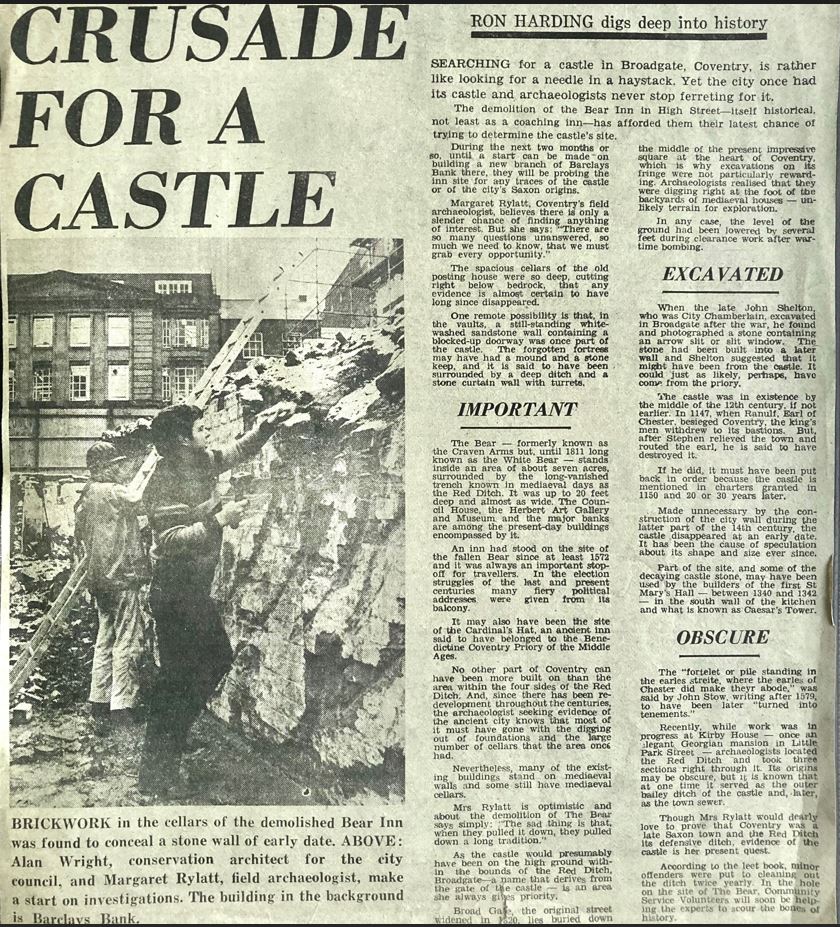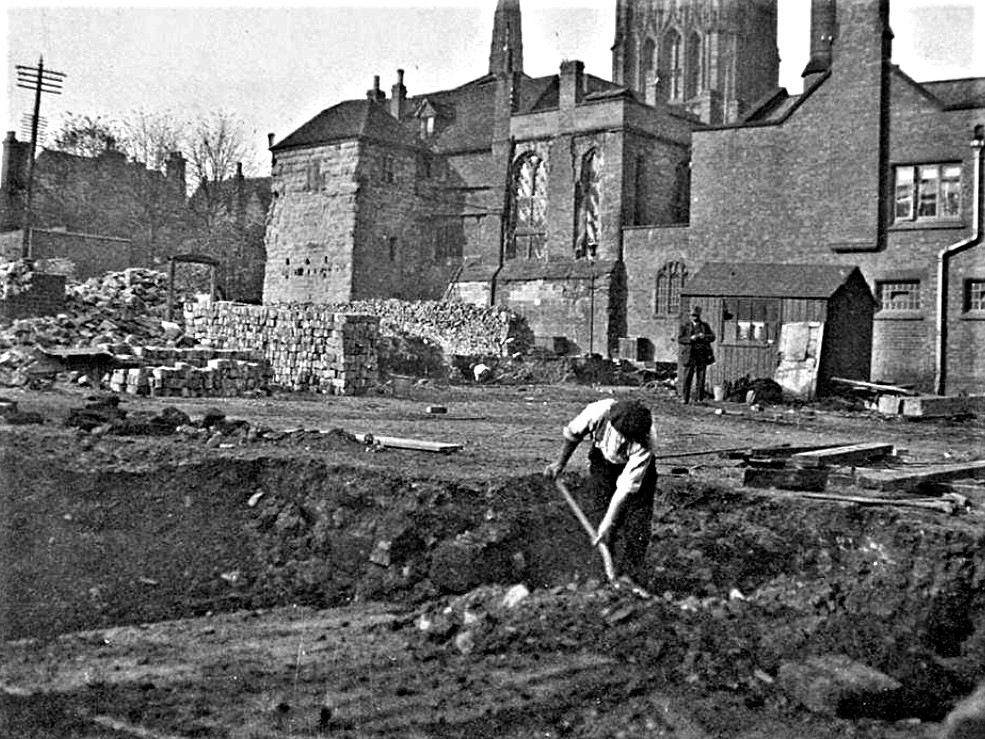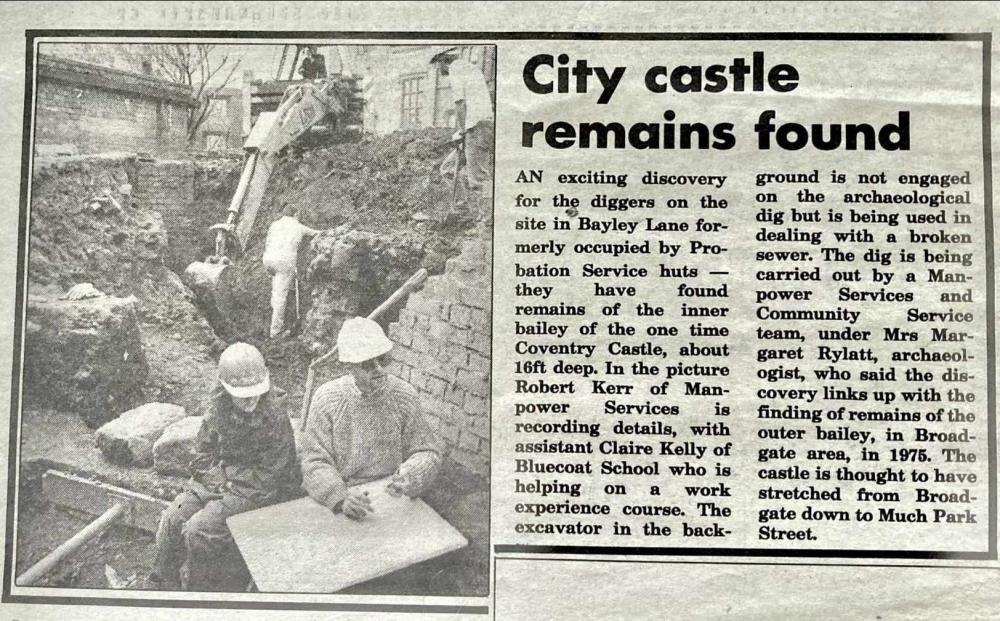|
NeilsYard
Coventry |
76 of 92
Thu 13th Apr 2023 10:18am
Sorry both it was posted on FB by my mate Tony McSweeney. I'll reach out to him to see if it was dated and where it originated from. |
| Local History and Heritage - Coventry Castle | |
|
NeilsYard
Coventry |
77 of 92
Fri 14th Apr 2023 12:06pm
Tony has confirmed back for that clipping - it was in the Telegraph - dated 23rd May 1974. |
| Local History and Heritage - Coventry Castle | |
|
Helen F
Warrington |
78 of 92
Sat 15th Apr 2023 5:10pm
I think that it's the same map as Anne's here. There is an updated version out but it used to be available online. |
| Local History and Heritage - Coventry Castle | |
|
Rob Orland
Historic Coventry |
79 of 92
Sun 24th Sep 2023 11:32am
As mentioned in the Allwoods & Atkins and Turton / Martins Bank topic, there was a good article written about Coventry's Castle in the Coventry Herald on the 22nd January 1938. |
| Local History and Heritage - Coventry Castle | |
|
Helen F
Warrington |
80 of 92
Sun 24th Sep 2023 12:52pm
An interesting read. |
| Local History and Heritage - Coventry Castle | |
|
NeilsYard
Coventry |
81 of 92
Mon 8th Jan 2024 3:33pm
Thanks to Tony McSweeney who kept a collection of great snippets from the Telegraph. Dated 21/01/81

|
| Local History and Heritage - Coventry Castle | |
|
Helen F
Warrington |
82 of 92
Mon 8th Jan 2024 5:10pm
|
| Local History and Heritage - Coventry Castle | |
|
Rob Orland
Historic Coventry |
83 of 92
Tue 9th Jan 2024 9:45am
It's a shame really that parts of the Council House were built too close to the rear of Caesar's Tower and the guildhall, because it would've been nice to be able to excavate the location where we think there could've been a mirror-image tower, forming a wedge-shaped entrance to a castle. I'd also love to know if the two rather substantial parallel (or not?) walls, in this old library picture below, were part of such an entrance?

|
| Local History and Heritage - Coventry Castle | |
|
Helen F
Warrington |
84 of 92
Tue 9th Jan 2024 10:32am
It would be a great subject for the city's experts to pull all the evidence together and combine with knowledge about how castles were designed. In Troughton's drawings there are random bits of wall that look like they could have originally belonged to something else. Various digs have found ditches but I've never seen them all plotted on one map. I think that the older cellars also have something to say about the oldest ditches too. I think that Shelton would have made more discoveries if he had had access to the Board of Health map as he describes in some of his dig finds, features that were still visible above ground in 1850. Sadly the round tower he found near Derby Lane turned out to be a much later garden feature. |
| Local History and Heritage - Coventry Castle | |
|
NeilsYard
Coventry |
85 of 92
Tue 9th Jan 2024 11:08am
Another one from Tony - I think this one must be the bit at the back of Browns/Metropolis by the side of St Mary Street -

|
| Local History and Heritage - Coventry Castle | |
|
Helen F
Warrington |
86 of 92
Tue 9th Jan 2024 11:38am
This area on the bottom left, looking left and slightly towards the Council House? |
| Local History and Heritage - Coventry Castle | |
|
NeilsYard
Coventry |
87 of 92
Tue 9th Jan 2024 11:49am
I think so Helen yes. The area is now all boarded off and hidden away again for some reason. |
| Local History and Heritage - Coventry Castle | |
|
Helen F
Warrington |
88 of 92
Tue 9th Jan 2024 2:32pm
That was the area they were re-excavating recently.
There have been multiple finds of a ditch running along the back of St Mary's Hall. I think that it was the ditch surrounding a bailey and most probably it extended east to the other side of Bayley Lane and north to cut under the north half of St Michael's (which has crypts). A corner of the spire is partly on a ditch but I'm not sure if they've determined its purpose. My theory is that the cellar under the entrance to the Herbert was also sunk into the ditch. It would explain why there was a window as it might have looked along the dip of the ditch as it ran north. Why dig a new hole in the ground if there was already one there that needed filling? It's the west end that's more unknown and the area where the castle proper was sited. Was there another inner bailey, encompassing a keep, or just a keep? The castle keep was essentially a set of panic rooms and not meant to be palatial, even if later versions became so. It would contain the essentials for life, including a small chapel room and a well. The entrance was usually quite physically difficult to access which made the keep inconvenient for day to day use, even in times of trouble. When no longer needed as a keep, a doorway was sometimes knocked through at ground level and the building reused. Directly outside the keep there could be small number of buildings, circled by a wall and ditch, that could be abandoned or even torched by soldiers if that inner bailey was breached. The next bailey outwards contained the main kitchens, halls, comfortable accommodation, stabling and main chapel (St Michael's). One thing about keeps was that they were sometimes/often repurposed as prisons once they were no longer needed as panic rooms. The prison on the 1749 map was on the junction of Pepper/Gaol Lane and Cuckoo Lane but it might have shifted location over the years before that.
There was a ditch running up to the corner Hay Lane and Bayley Lane (under the chapel destroyed by the war). Was the keep in the area to the east of that ditch or to the west? Because the later prisons were to the west of it, my feeling is that the keep was to the west of that ditch. The other reason I think the keep/inner bailey was to the west of Hay Lane is because I think that Bayley Lane was the road leading out into the bailey from a gatehouse. I also don't think Bayley Lane ran around the outside of the bailey. I think that the castle bakehouse, discovered near St Mary's Hall served the comfy part of the castle. |
| Local History and Heritage - Coventry Castle | |
|
Helen F
Warrington |
89 of 92
Thu 14th Mar 2024 4:08pm
I have mooted the idea that the keep for the castle might have been reused as the gaol. As they often were. I know that the gaol in 1749 was on the corner of Cuckoo Lane and Gaol/Pepper Lane because it's on Bradford's map, but it was a rebuild, some time after the Civil War (and before the current Courthouse). It's very hard to know if older buildings were demolished and then rebuilt or a new building was built on a new plot and then the old one demolished. However while trufflling through the Herbert records I found this about a messuage which Richard Pryste inhabits on the western side of Cuckoo Lane, lying between the poulterer Richard Tullye's tenement on the north and the gaol hall on the south thus pinpointing the gaol in 1575. It is believed Mary Queen of Scots was imprisoned at the Guildhall when she was brought to the city in 1569 from Tutbury. From memory the remains of the castle (no mention of the gaol) were deemed too rundown to house her. What do you think?
The smaller house in the picture below might be Mr Pryste's house. I believe it had stone walls on the ground floor and timber framing above.

|
| Local History and Heritage - Coventry Castle | |
|
NeilsYard
Coventry |
90 of 92
Fri 15th Mar 2024 12:15pm
I think we need to bow to your infinite wisdom Helen! Awesome work |
| Local History and Heritage - Coventry Castle | |
Website & counter by Rob Orland © 2024
Load time: 673ms